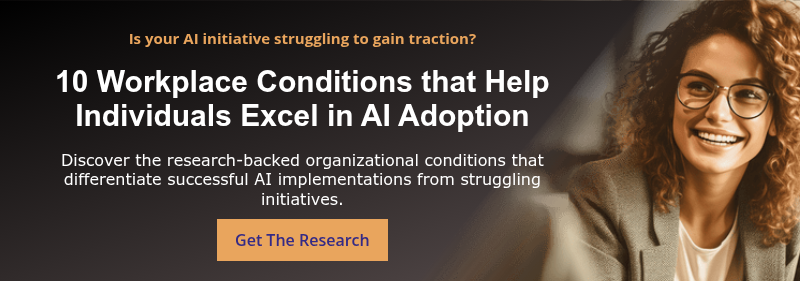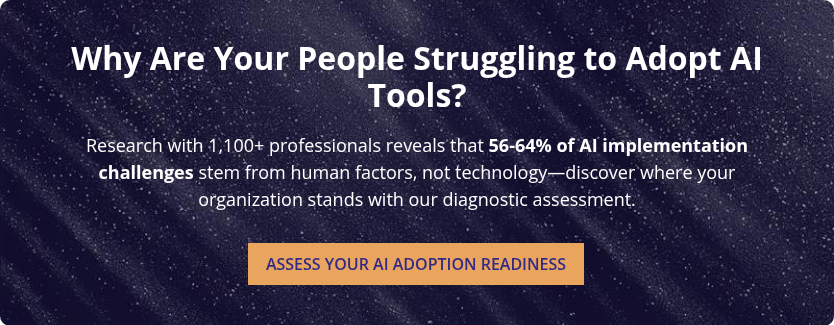8 Ways AI-Driven Change is Different (And What Change Leaders Must Know)

5 Mins
Updated: December 23, 2025
Published: June 12, 2025

Organizations investing millions in AI technology often fail to realize expected returns, not because of technical failures, but because they're applying traditional change management approaches to a fundamentally different type of transformation.
What Prosci’s AI Research Reveals About AI Change
Recent Prosci research studying 1,107 professionals across organizational levels reveals the scope of AI adoption challenges which organizations are facing. The data is striking:
Prevalence of Human vs. Technical Challenges of AI Adoption

- Human vs. Technical Challenges – User proficiency emerged as the primary challenge, accounting for 38% of all reported AI implementation difficulties. This breaks down into learning curve challenges (22%), prompt engineering struggles (11%), and inadequate training (6%). Technical implementation issues account for only 16%. This represents a fundamental shift from traditional technology rollouts where technical challenges often dominate.
- The Trust Gap is Measurable – The research reveals significant trust disparities across organizational levels. Frontline workers report minimal trust in AI (+0.33 on a -2 to +2 scale), while executives demonstrate significantly higher trust levels (+1.09).
- Leadership Support Drives Success – Organizations with "very smooth" AI implementations show dramatically different leadership characteristics. They demonstrate strong leadership support (+1.65) compared to struggling organizations (-1.50).
These numbers underscore what workshop participants have been telling us—AI change is fundamentally different, and traditional approaches aren't sufficient.
8 Key Differences in AI-Driven Change
Over the past six months, we've conducted AI adoption workshops with hundreds of change practitioners across industries in North America. Through polling data and feedback from attendees who are experts in their organizations, eight distinct patterns have emerged that separate AI transformation from traditional change initiatives.
1. The "never-ending phase 2" challenge
Traditional change management operates on defined phases with clear endpoints. AI adoption breaks this model. As one workshop participant put it, "AI changes so fast—what are we chasing?" Another described it as a "never-ending Phase 2."
The technology evolves rapidly, new capabilities emerge constantly, and organizations must adapt their implementations in real-time. Your change management plans need flexibility and agility, not one-time delivery. Reinforcement becomes an active process of continuous readiness rather than a finite goal.
Successful practitioners are building adaptive, modular change plans and coaching sponsors to maintain visibility over longer, less predictable timelines.
Aligning The Prosci ADKAR Model to Iterative Changes

2. Security concerns reshape risk management
AI introduces elevated risks that traditional change management rarely encounters. Workshop participants noted a "heightened level of security concern" where "individual responsibility and risk mitigation become more important."
AI systems can inadvertently expose sensitive data, generate inaccurate information, or create new vulnerabilities. The consequences in sensitive contexts—healthcare, finance, legal—can be severe.
This demands that risk management be integrated directly into every change management activity. Awareness campaigns must prioritize responsible behavior alongside tool adoption. Training programs need security-focused messaging woven throughout, not added as an afterthought.

3. Ethics and governance take center stage
Unlike traditional technology implementations, AI decisions can perpetuate bias, generate misinformation, or impact people's lives in ways that aren't immediately visible. Workshop participants consistently raised "ethical and responsible use" and "ethical and bias concerns" as central challenges.
Building awareness must explicitly include ethical considerations, not just operational changes. Sponsorship coalitions need to visibly model ethical behavior to set the organizational tone.
Forward-thinking practitioners are creating visible feedback channels to identify and course-correct ethical risks early, integrating policy updates directly into knowledge-building activities.
4. The shift to individualized learning
Traditional training approaches fall short with AI adoption. The technology demands personalized, self-directed learning to build sufficient literacy. As one expert noted, organizations need to "build competencies to ensure resilience and flexibility to engage in continuous learning."
AI tools apply differently across roles, departments, and individuals. A marketing specialist might use AI for content creation, while a financial analyst applies it to data analysis. Generic training programs can't address this variety effectively.
Successful practitioners are offering multi-path learning experiences: AI academies, peer-to-peer learning networks, and resource hubs that people can access based on their specific needs.
5. Scale and complexity demand enterprise thinking
AI implementations often affect multiple departments simultaneously, without clear boundaries. Workshop participants described "the scale of it all—change, speed, etc." with "AI potentially having no limits."
Traditional project-based change management approaches struggle with this scope. AI adoption requires enterprise-wide perspective, broader stakeholder impact assessments, and sponsorship coalitions of senior leaders.
The complexity isn't just technical—it's organizational. AI implementations trigger cascading changes across business processes, decision-making frameworks, and organizational structures.

6. Navigating ambiguity in future states
Traditional change management excels at moving from clearly defined current states to well-articulated future states. AI adoption challenges this model. Participants noted "no clear 'tomorrow' state" and difficulty "defining the future state clearly."
AI capabilities evolve rapidly, and organizations can't predict exactly how they'll use the technology six months from now. The solution isn't to wait for clarity—it's to equip people to navigate ambiguity confidently.
Practitioners are framing communication around progress markers rather than final destinations, reinforcing organizational purpose to anchor people even as tactics evolve.
7. New forms of resistance require new responses
AI evokes distinct resistance that goes beyond typical procedural concerns. Workshop participants described "different and new types of resistance, more fear-based, around risks, unknown factors, loss of relevancy, and societal impacts."
The fears are deeper and more personal. People aren't just worried about learning new processes—they're concerned about their fundamental relevance in an AI-enhanced world.
Standard resistance management techniques aren't sufficient. Practitioners need to address emotional drivers, not just procedural hurdles. Building desire becomes harder because the perceived threat feels existential.
8. Reshaping roles and work dynamics
AI significantly impacts roles, responsibilities, and workplace dynamics. Participants noted major implications for the "future of work and roles" with "knowledge and ability varying from team to team."
This isn't just about learning new tools—it's about fundamental work redesign. AI changes how people spend their time, what skills they need, and how they create value.
Practitioners are building future-state role maps showing how AI complements human capabilities and reinforcing an organizational narrative of partnership with AI rather than competition.
Early Warning Signs and Success Indicators
Our research reveals clear patterns distinguishing successful AI transformations from struggling ones. Organizations with "very smooth" implementations demonstrate dramatically different characteristics:
- The Experimentation Gap – Organizations with "very smooth" implementations strongly encourage trying new tools, while those "making progress with challenges" show moderate encouragement. Organizations struggling with implementation actually discourage trying new tools. This stands out as one of the strongest predictors of AI implementation success.
- Leadership and Cultural Alignment – Successful organizations demonstrate strong leadership support and organizational culture that actively supports AI-driven change.
- Data Openness Balance – Organizations with smooth implementations show higher data openness compared to struggling organizations, demonstrating the importance of balancing security with accessibility.
Warning Signs to Watch For:
- Executives expressing high confidence while frontline workers show resistance
- Security concerns being treated as separate from change management
- Training approaches that don't account for role-specific AI applications
- Discouraging experimentation rather than fostering safe exploration
Adapting Your Change Management Toolkit
Traditional change management tools require thoughtful adaptation for AI adoption success. Our Prosci ADKAR Model remains relevant, but awareness-building must encompass ethical considerations and continuous learning expectations rather than just operational changes.
Communication strategies need to emphasize progress markers over final destinations while addressing the measurable trust gap between organizational levels. Training approaches must shift from one-size-fits-all to personalized learning journeys that build adaptability skills alongside technical competencies.
Perhaps most critically, sponsorship requirements expand beyond individual project sponsors to coalitions of senior leaders who can maintain visibility and model ethical AI behavior over extended, less predictable timelines.
Preparing for Continuous AI Evolution
AI adoption isn't a destination—it's an ongoing journey of organizational capability building. The most successful organizations treat AI change management as a core competency, not a project deliverable.
This means building internal expertise in AI-specific change patterns, developing organizational agility for continuous adaptation, and creating cultures that embrace rather than resist AI-driven evolution.
AI adoption success depends more on managing the human side of change than on the sophistication of the technology. For change practitioners willing to adapt their approaches, this represents both a significant challenge and an unprecedented opportunity to demonstrate the strategic value of expert change management.
Make A Strategic Investment in Adoption
AI adoption is more than a technical implementation—it’s a transformation in how your people work, innovate, and deliver value. The path to success requires deliberate strategies to engage employees, align leadership, and integrate AI into workflows.
By partnering with Prosci, you’ll gain a trusted guide with the research, methodologies, and expertise to manage the people side of AI adoption effectively. With Prosci, your organization will not only achieve the full promise of AI but also build the change resilience needed to navigate future transformations.
Partner with Prosci to unlock the full potential of your AI initiatives—and secure lasting competitive advantage in an AI-powered future.




